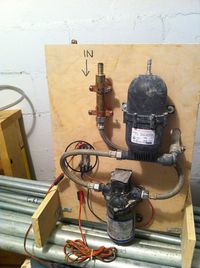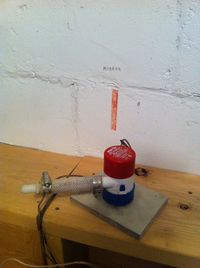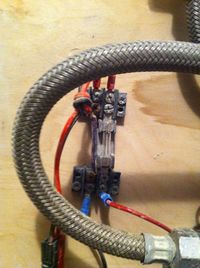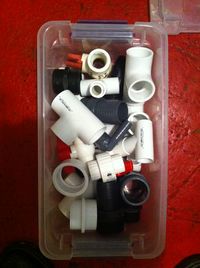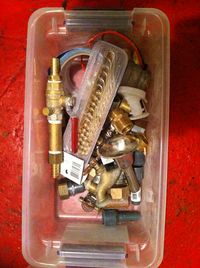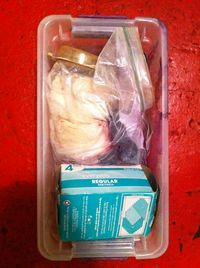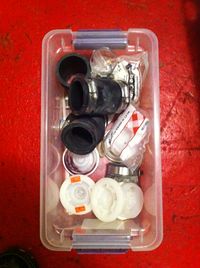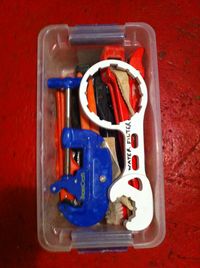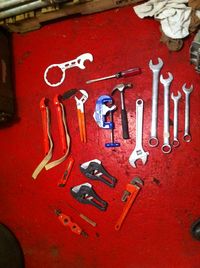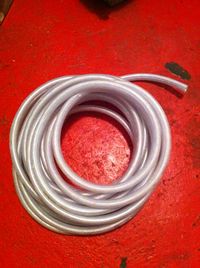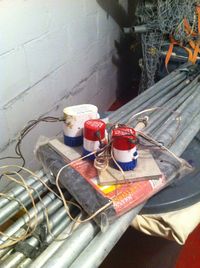Current-water-documentation
Standards
We've made an effort to standardize all water components on a few sizes and connector types. Conforming to these standards ensures interoperability of parts, reduces the number of spare parts needed, and improves reliability by making the system as a whole more flexible.
All fresh water lines are 1/2" ID. For durability sake we favor copper pipe over PVC. All fresh water tubing is 1/2" ID reinforced vinyl tube. The fiberglass reinforced hose is good for handling the pressure and will hold up to a moderate vacuum without crimping. All hose connectors are brass barb fittings. This means that any hose can be connected to any other hose in the system, no messing around with adapters. Brass barb fittings are more durable than the PVC variants and insert with less effort.
All drain pipes are 1-1/2 PVC pipe.
The water systems use two kinds of power, 110V AC mains power and 12V DC. Again, conforming to these standards improve the reliability of any power consuming system. All 12V power connectors are Anderson Powerpole 30 amp connectors
Inventory
Reno
In the Reno container or storage locker there should be:
- kitchen sink
- two water barrels
- the water barrel tap
Seek confirmation from last years late crew that these things are out in Reno. [Confirmed for 2014 by Liz M.]
Boston
The rest of the water pod hardware should be in Boston. It mostly fits in four crates, two ALC's, and two yellow and black plastic tubs. Inventory all of these items, pre-playa. Make sure everything is accounted for. Test the main components. Mend anything that is broken. Replace and refill consumables. In the Boston components you should find:
- around 100ft of 1/2 ID tubing Media:Water_15.JPG
- sink pump assembly Media:Water_03.JPG Media:Water_04.JPG
- sink faucet Media:Water_02.JPG
- 12V UPS Media:Water_06.JPG
- 12V deep cycle battery
- sink drain assembly Media:Water_07.JPG
- a bunch of threaded 1-1/2 PVC modular drain tubes
- grey water sump pump Media:Water_15.JPG
- extra PVC fittings Media:Water_08.JPG
- extra brass fittings Media:Water_09.JPG
- extra misc fittings Media:Water_11.JPG
- tools Media:Water_12.JPG Media:Water_13.JPG
- large flathead screw driver
- assorted crescent wrenches
- strap wrench
- filter housing wrench
- PVC pipe cutter
- metal pipe cutter
- copper pipe brush
- consumables Media:Water_10.JPG
- PVC primer
- PVC cement
- teflon tape
- fresh water filter
- o-rings General Electric ws03x10038 for the filter housing
- food safe lubricant
- panty-hose
Description
Fresh Water
Barrels
We stage our fresh water in two 55gallon drums, placed behind the kitchen. Autosub used to bring all of their water out in 14 drums. Now we just have the two drums and we refill them from the Hive water tank.
Keep both barrels full. One of the barrels is tapped and feeds the sink pump. When that barrel is emptied then move the tap from the empty barrel to the full barrel. Fill the now empty barrel from the Hive tank. The Hive tank should have a pump and GHT spigot provided by the water service. Autosub should have a garden hose long enough to run from the water tank all the way to where we are storing the barrels. When you fill a barrel log that Autosub has used an additional 55 gallon's of Hive water. There should be a log affixed to the tank. Water barrels may be emptied at any time so it's important that everyone in camp understand the process of filling a new barrel.
Pump Assembly
Water is pumped from the water barrels and brought up to an operating pressure of 32psi by the pump assembly. The fresh water pump has a pressure switch on it so that when the faucet is closed and the pressure hit 32psi the pump will shut off. When you open the faucet the pump comes back on automatically. It provides water on demand. The pump is self priming, it will pull air out of the barrel lines. However it can get vapor locked. This is when a bubble of air is trapped in the pump. The pump will not be able to get this air up to full pressure and will therefore continue cycling and never shut off. Don't let this happen! It might burn out the pump. If the pump is vapor locked you need to run the tap, bleed the lines until there is no air bubbles in the lines. Vapor lock is especially common when you switch barrels and there is therefor a lot of air in the lines.
After the pump in the pump assembly you will find an accumulator reservoir. This device can be mostly ignored. It just serves to even out demand, prevent rapid cycling of the pump, and reduce the likelihood of vapor lock. But you don't have to do anything with it.
After the accumulator is the water filter and water filter housing. You can open the filter housing by hand or with the housing wrench. Be careful when closing the housing. Don't cross the threads. Make sure the filter is properly seated on both nipples. Don't damage the filter. You shouldn't need to open the filter housing on playa at all. You only need to do it when replacing the filter. As long as the filter is stored dry it should last many years.
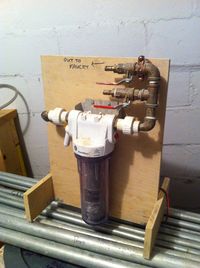
Power
Power for the fresh water pump assembly is provided by the 12V UPS (Uninterruptible Power Supply). This consists of a battery charger, 12V DC supply, and marine deep cycle battery. The UPS plugs into the 110V AC mains power when it becomes available. The battery plugs into the UPS and the UPS plugs into the pump assembly. The UPS provides 12V DC power to the pump assembly. It provides that power from the 12V supply if it is available. If mains power is not available then it provides power from the battery. It also keeps the battery charged and well conditioned.
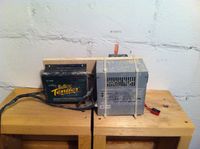
Faucets
The pump assembly has two outputs. These are brass barbed nipple connectors. One is attached to the kitchen faucet by a 1/2" ID vinyl tube. The faucet is a sturdy brass fixture attache to a two by four. The faucet can be attached to the splash board above the sink with a C-clamp or whatever is handy. Normally the faucet has two inlets, one for hot water and one for cold. We only have one kind of water so the right hand inlet is sealed off and the right hand side valve does nothing. The left hand side inlet has a barbed nipple fitting where it connects to the pump assembly. Off the side of the kitchen faucet there is a spray hose for washing pots and pans or for filling large pots. You may also attach a hose and valve to the pump assembly's other output. This hose is very useful for filling large pots of water.
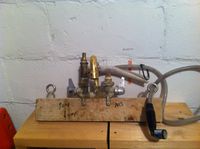
Grey Water
It used to be that Autosub disposed of it's grey water through an evaporation system. Now we dump into the Hive's grey water system. But otherwise the system is pretty much unchanged. We still drain into a staging tank and we pump out of that staging tank. Were before we would have pumped into the filter/evap system, now we pump into the Hive grey water tank.
Drain
Both the kitchen sink and the shower drain into the grey water staging tank.
The shower drain pipe is in the shower base and just goes the short distance to the tank.
The sink drain is a piece of PVC T connection with to flanged stand pipes as inputs and a bare PVC pipe as output. The flanged stand pipes are connected to the PVC with collared pressure fittings and are adjustable height. The flanged end of the stand pipes each connect to the basket drain of one of the sink basins. The bare output end connects to the sloping drain pipe with a rubber flexible coupling. The drain pipe runs at a gentle grade, out of the kitchen and into the tank placed behind the kitchen. The drain pipe is made of a series of PVC lengths with threaded connectors on each end. In this way all the drain pipes can be adjusted to any desired length.
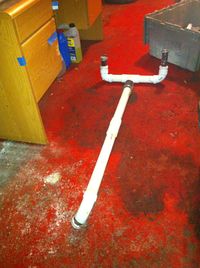
Staging Tank
The grey water staging tanks is made of the same black plastic tub that all of the grey water hardware was shipped in. It contains a coarse basket filter (office waste paper basket) and a sump pump. All grey water drains into the tank through the coarse filter. The sump pump is connected to a small length of PVC stand pipe and finally to a 1/2" ID PVC barbed nipple. This is connected, by vinyl tube, to the Hive grey water tank. The sump pump is powered by 110V AC and is controlled by a float switch attached to the stand pipe. The float switch is adjusted so that it switches on when the tank is full and switches off just as the pump begins to cavitate. When the staging tank fills the sump pump empties the tank into the Hive grey water tank, then shuts itself off.
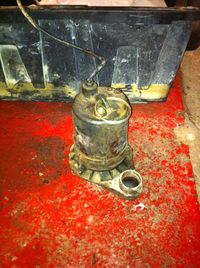
Tasks
Pre-playa
- Inventory all water hardware. Make sure that all Boston-located hardware is accounted for. Seek explicit confirmation from last year's crew that all Reno hardware is accounted for. Measure the roll of 1/2in tube and ensure we have enough.
- Determine the exact locations of the Hive fresh water tank, the Hive grey water tank, and the Autosub kitchen. Make sure we have enough hosing and tubing to reach the tanks.
- Check the water levels on the 12V marine battery. Refill with distilled water as necessary.
- Check that the 12V marine battery takes and keeps a charge.
- Examine all consumables. Make sure they are still in good condition and of sufficient quantity. PVC cement especially likes to dry out in the crappy bottles it's sold in.
- Test the entire fresh water system. Take a five gallon bucket and fill it with water. Run a tube from the bucket to the input of the pump assembly. Run a line from the output of the pump assembly to the input of the faucet. Mount the faucet so that it empties back into the test bucket. Plug the battery into the UPS. Plug the UPS into the wall. Make sure the filter is seated properly and the housing is closed tight. Turn it all on by plugging the UPS into the pump. Verify that the pump works and supplies water to the faucet. Verify that there are no leaks. Verify that the pump correctly shuts itself off. Verify that the UPS provides power and that the pump works both with and without mains power.
- If anything is broken, fix it.
Playa-Setup
Bootstrap Water
People are thirsty and they're not going to wait. Your first job is to get the water running--before power and the kitchen are set up.
One of the barrels should have been filled in Reno and brought out to the playa, so you have water before the tank arrives. Tap the barrel and run a line from the tap to the pump assembly. Make sure both outputs of the pump assembly are closed and that everything else is tight. Then, run a line from the pump assembly to the quick-flow valve.
Now, power the pump. Connect the battery to the UPS and the UPS to the pump. The system should pressurize and there should be no leaks. The pump will probably vapor lock. If everything checks out then open the valves and bleed the lines back into the barrel until there are no more air bubbles and the pump shuts off and doesn't vapor lock.
Hive Water
Once the hive water tank is placed run a garden hose from it to the Autosub water barrels. Trench or suspend the hose as needed so that we can have it deployed and aren't tripping over it. The Hive water tank should have a spigot with GHT on the mouth. We can attach the hose to that. If we have a Y-adaptor we can leave our hose attached all week. If we do not we can't and it will be a pain.
Kitchen Sink
Once the kitchen is built, drop in the sink. Attach the faucet to the backsplash with the C-clamp and run a line from the faucet to the other pump assembly output. Place a bucket under the sink for temporary grey water collection.
Grey Water
Now set up the rest of the grey water system. Place the grey water staging tank behind the kitchen. Make sure there is a straight line from the sink to the tank for the drain pipe.
Now attach the drain pipe to the sink. Attach the stand pipes to the sink basins. Adjust the T connections and the stand pipe. Screw together the drain pipes and attach this to the T. place the coarse filter basket into the grey water staging tank. Drain the sink into the coarse filter. Place the sump pump in the grey water staging tank. Run a line from the sump pump to the Hive grey water tank.
Power
Eventually mains power will become available. When this happens plug the UPS into mains power. The fresh water system will automatically switch over to using mains power.
Plug the sump pump in and adjust the float switch on the stand pipe. Make sure that the float switch will trip on before the tank overflows. Make sure that the float switch will trip off before the pump reaches its minimum depth. Otherwise the pump will never turn off. Watch the grey water staging tank empty into the Hive tank and make sure that everything is working properly.
